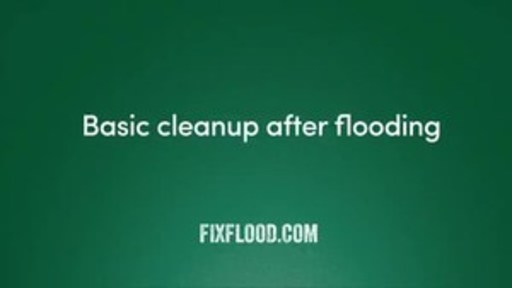Storm and Flood Damage: Follow These 10 Steps to Protect Your Home and Health
Safe practices and products for keeping moisture, pests and fungi away
HOUSTON, Sept. 25, 2017 /PRNewswire/ -- Nisus Corporation- Restoring a home impacted by massive damage and destruction due to severe flooding poses great health risks for residents and requires knowledge beyond the basic definition of "clean". Hazardous matter that can lead to illness can infiltrate floodwaters and leave behind dangerous pathogens once the water recedes. A recent Texas A&M study found high concentration levels of E. coli post Hurricane Harvey – almost 125 times the acceptable rate – and the lack of knowledge regarding safe cleanup practices and products places residents in a risky situation.
"Bleaching a home down can seem like the best move to make when you're trying to remove potential pathogens or fungi. But despite the popular belief, bleach isn't the most effective solution, and homeowners should definitely avoid using it on wood studs, as it can damage the lignins and actually degrade the wood," said Jim Gorman, vice president of marketing at Nisus Corporation (Nisus), a Tennessee-based manufacturer of sustainable pest management products. "Homeowners should choose products that are EPA registered disinfectants, sanitizers and virucides when treating their homes. For protecting wood, they should choose a borate-based product supplemented with a mold-control agent because this chemical deals with the mold while the borates control wood decay fungi and wood destroying insects such as termites. It also provides residual protection for the life of the wood."
Though it is recommended to hire experts to handle extreme home restoration projects, many individuals do not have the appropriate insurance or resources to pay professionals to remove potentially hazardous organisms. While pathogens and pests thrive in areas with high levels of moisture content, homeowners lacking awareness may not address the issues properly or apply products appropriately to kill the root of the problem.
For those choosing to take on the task of cleaning and restoring themselves, Nisus has provided a step-by-step process to ensure cleanup efforts remain safe and effective.
Step 1: Gear up
Make sure the structure is safe to enter. Wear appropriate protective gear from head to toe: protective goggles, N95 respirator face mask, long-sleeve shirt, gloves, long pants and muck boots. Make sure the electricity and HVAC are off.
Step 2: Disinfect
Disinfect the entire previously flooded area with an appropriate EPA registered disinfectant, sanitizer and virucide like Nisus DSV™. This helps reduce the exposure to E. coli and other harmful pathogens when cleaning.
Step 3: Gut it out
Begin removing mud, flooded furniture, appliances, carpets and flooring that have been exposed to water for more than 24-48 hours.
Step 4: Cut it out
Cut out drywall 2 feet above the highest water line to allow for proper drying. If drywall is being removed above 4 feet, consider removing all drywall for simpler installation of new drywall. If mold has started to grow above the water line, then all the drywall must be removed. Once the drywall is removed, apply a second application of disinfectant.
Step 5: Remove the stains
To remove mold stains, spray affected areas with Mold-Clean®, scrub as necessary, then rinse with clean water.
Step 6: Kill mold and prevent wood decay
To kill mold and stop wood decay, treat all exposed wood by using an EPA registered product such as Bora-Care®with Mold-Care® in a 5:1 solution. Wood can still be wet when this product is applied. For solely treating wood, look for a product that combines a moldicide with Disodium Octaborate Tetrahydrate (DOT), a natural mineral salt, as an active ingredient. It remains for the life of the wood and provides residual protection.
Step 7: Rebuild termite barrier
Any previous termite protection on your home is lost during flooding. Reapply termite protection with a 2-foot band treatment using Bora-Care in a 1:1 solution. Application by a professional pest control company is necessary to receive a termite letter or other appropriate certification.
Step 8: Air it out
Begin circulating fresh air using fans and dehumidifiers if available.
Step 9: Check the moisture
If you install drywall before the wood has completely dried, you can be susceptible to mold growth in the future. Use a moisture meter to determine when the moisture content of the wood is 15% or below. At this point, the wood is dry, and the home is ready for drywall and flooring installation.
Step 10: Eliminate odor
If the home has odor issues, use a microbial odor eliminator spray like Bac-Azap® on all affected areas and repeat as necessary. These products not only eliminate the odor but also consume the organic matter, which is the source of the smell.
Nisus recently taught this 10-step process to pest control companies in Houston and will be training pest control companies in Florida in the coming weeks. Helping families disinfect and treat flood-affected wood is nothing new for the company. They have been helping homeowners after flooding for years. Nisus was on the ground in Louisiana for Hurricane Katrina and the 2016 historic flooding in Baton Rouge to provide free flood damage trainings.
For a full demonstration of Nisus' recommended steps, refer to the video here or visit FixFlood.com to download the10-step guide on storm and flood damage repair as well as to access helpful links.
About Nisus Corporation:
Nisus Corporation was founded in 1990 in Knoxville, TN and is the originator of Green Pest Management®. Nisus manufactures and distributes sustainable products for professional pest management, wood preservation, mold control, disinfecting & sanitizing, odor control, and pool and spa management. More information about the Nisus Corporation can be found at http://nisuscorp.com.
SOURCE Nisus Corporation
Related Links
WANT YOUR COMPANY'S NEWS FEATURED ON PRNEWSWIRE.COM?
Newsrooms &
Influencers
Digital Media
Outlets
Journalists
Opted In

Share this article